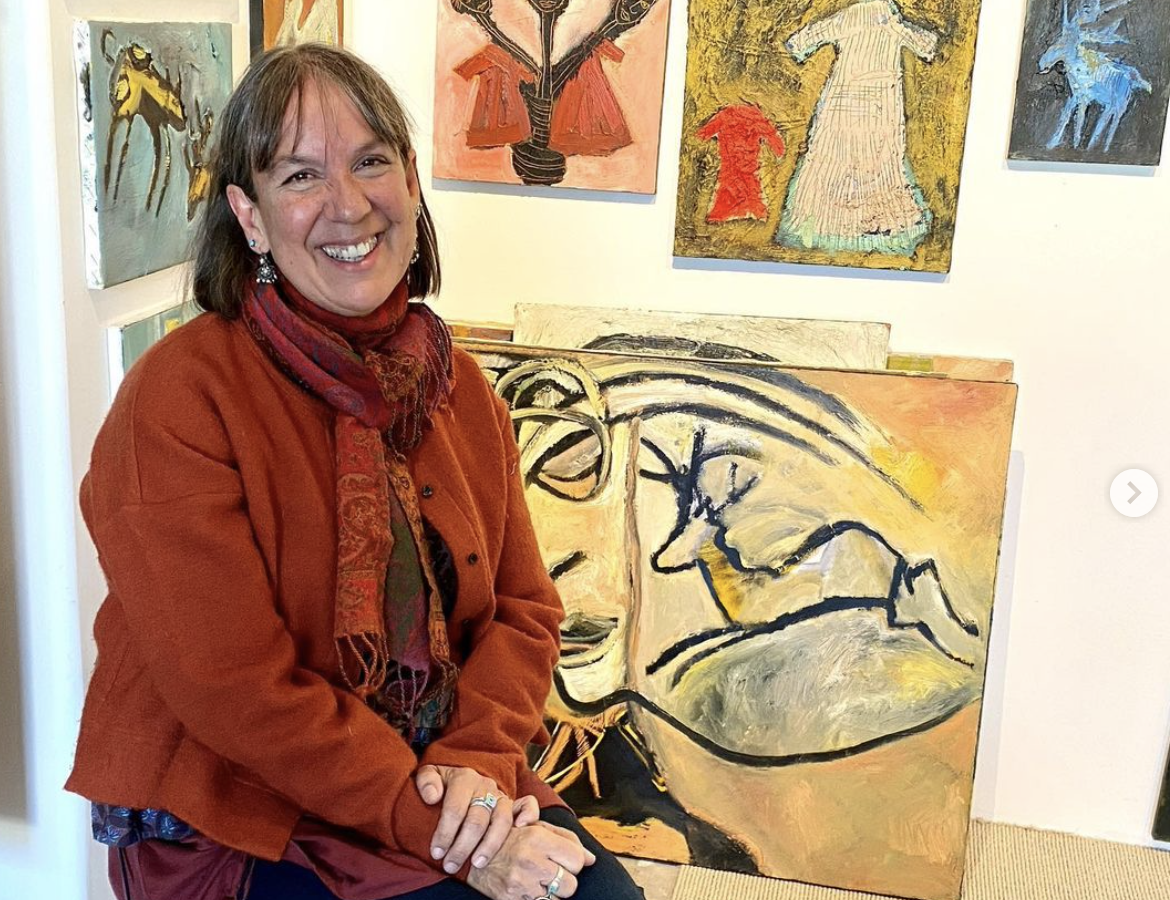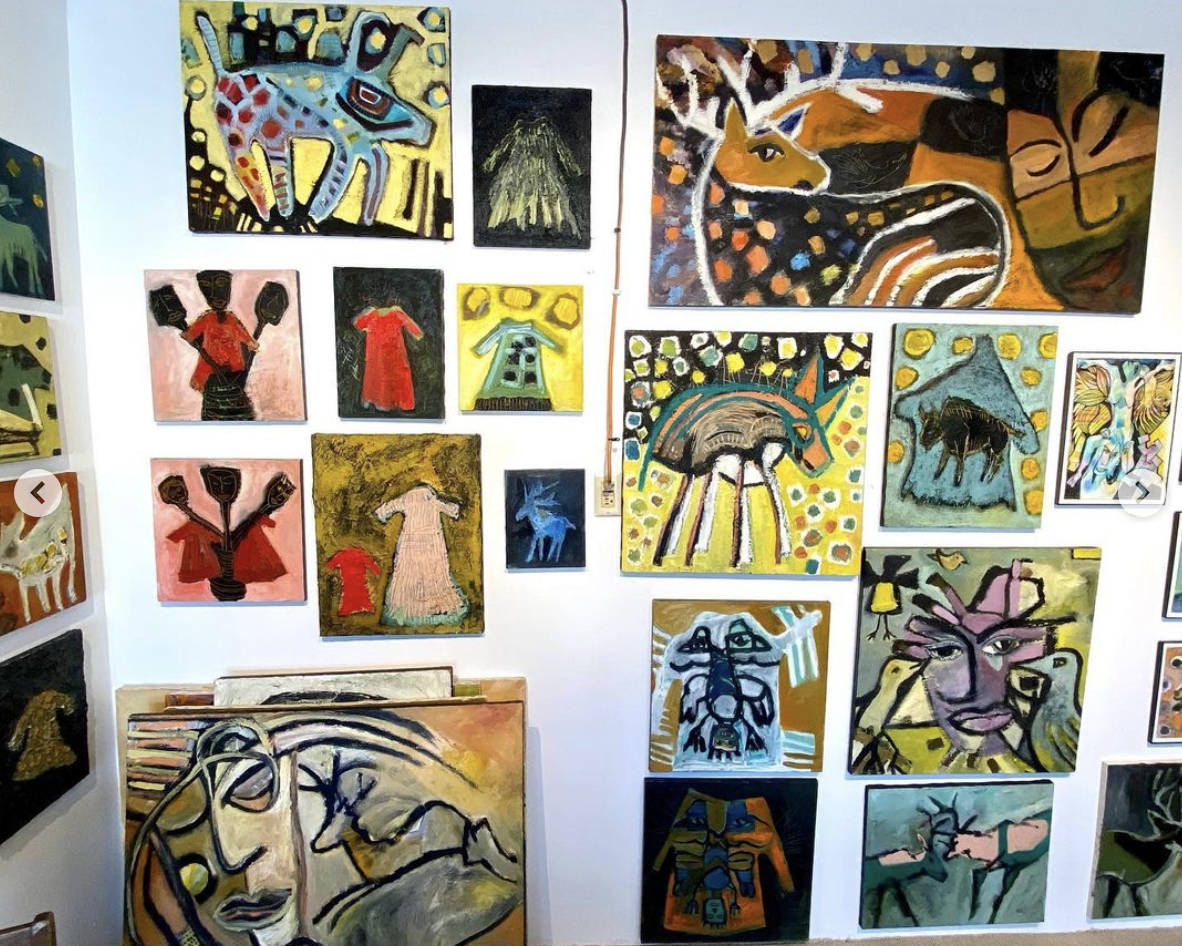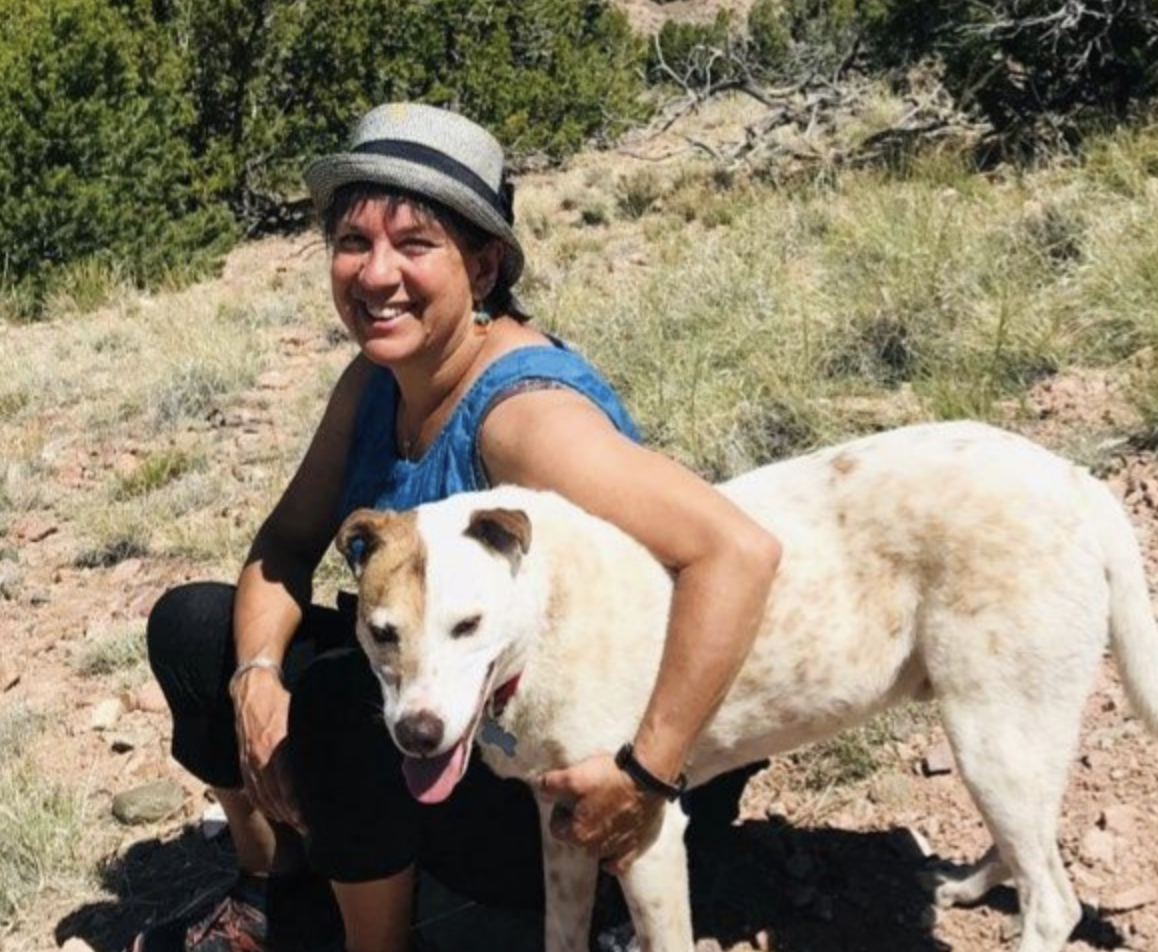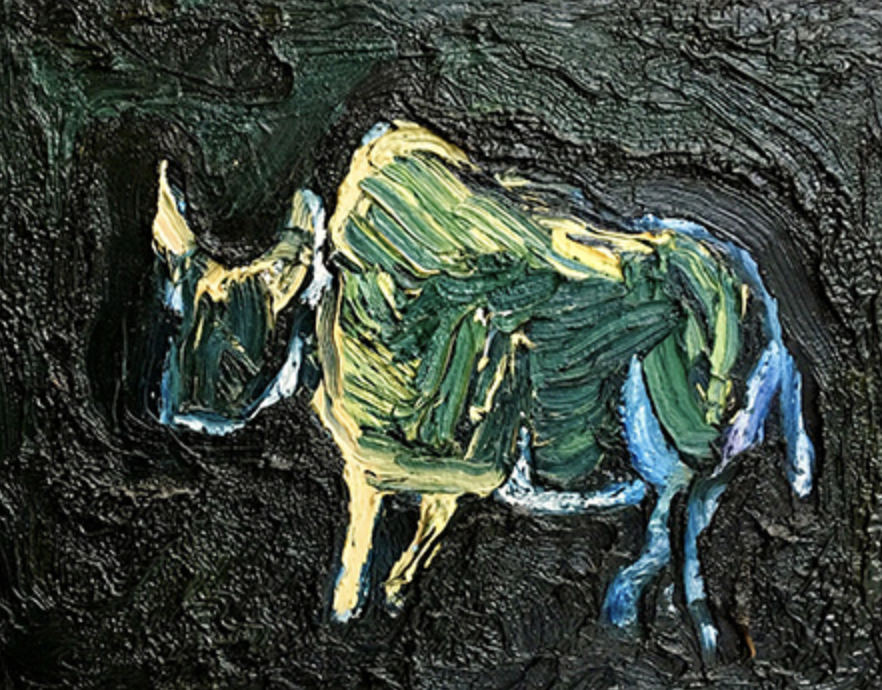NEWS
RECENT ARTICLES

Instagram Review by Richard Speer
View the original article here:
https://www.instagram.com/p/CU-XImnh9Nf/?utm_medium=share_sheet


I’m so happy I’m here at the same time my dear friend Selena Engelhart is participating in the Santa Fe Studio Tour. I met Selena in 1998, and we kept in touch and visited whenever I came to New Mexico. Her painting, “Night Buffalo,” was the first original painting I ever bought, and the profile I wrote of her in 2000 was the first artist essay I ever wrote. She is an old soul with a tremendous heart. Her paintings have always struck me as symbolist, iconic, shamanic, magical-realist, with a powerful elementality that reminds me of ancient cave paintings. Like the late Rick Bartow, she blends elements of the human, animal, and spirit worlds. Her newer works on paper advance this syntax and, to my eye, have a heightened narrative content. Buffalo, deer, “cosmic dogs,” mushrooms, self-portraits, dresses, and the Virgin of Guadalupe are among recurring motifs. It was so nice to reconnect with this gifted painter and seer, and talk about all sorts of deeply personal things that have been happening in our lives. The final installment of her open studio will be this coming weekend on Saturday and Sunday, October 16 and 17, from 10am to 5pm, at her home at 2074 Placita De Vida, Santa Fe. If you’re not in New Mexico, her website is www.selenaengelhart.com, and her Instagram is @selenaengelhartstudio. The website includes not only images of her paintings, drawings, and greeting cards, bio, etc., but also the profile I wrote those many years ago, as well as a piece I more recently wrote for Visual Art Source in which I explain why “Night Buffalo” means so much to me. #selenaengelhart #santafeartist#santafeart #openstudios#newmexicoartist #painting #drawing#contemporaryart

COMMUNITY MEDIA CENTER OF MARIN
Meet the Artist: Selena Engelhart (article below)
View the original article here:
Selena Engelhart – Ink Drawings from my Diaries & Paintings
I am a Mexican-American artist. Born in Los Angeles, I was raised in the Bay Area. My passion is an oil painting. I call my work visual music. It comes from a non-thinking place, a place of listening. When I paint, I listen to music, which frees my mind and allows a deeper side of myself to the surface and express itself. I see, not with my physical eyes, but with my listening ears. For me, art making is a visual language. It is immediate—transcending the limits of words.
The painting has a life of its own, which I work to uncover, discover, realize. I am really just the instrument for the creative energy that moves through me. I often have multiple paintings in process at the same time. They dictate to me when they are finished. I often draw to release emotional energy that I cannot express in any other way. I aspire to generate a positive experience, inspiring myself and anyone who views my art.
Themes
Animals – dogs, deer, hoofed beasts, cows, buffalo, birds
Energy and movement – animals in motion, going places
Color, texture, wet paint, sculpture
Other Work
Pen and ink drawings. This new work comes directly from my diaries.
Collage: sketches and studies in composition
Education:
1997 MFA Mills College, Oakland California
1995 Cooper Union, New York City
1992-1995 California College of Arts and Crafts, Oakland CA.
Meet the Artist
Please introduce yourself and describe your work.
My name is Selena Engelhart. I was born in Los Angeles, Ca. but grew up in Berkeley. I grew up in a very creative family. My father is a Jazz pianist and composer and is world renown for his Metal Percussion Instruments. My Mexican mother is a Political Activist who has worked tirelessly her whole life for civil rights. She is also a fine cross-stitch Artist. I have two highly creative younger sisters, one who is a Singer, composer, teacher and the other is an international Sound Engineer. I studied classical piano, dance, theater, and clay, painting, and collage as I grew up in the Bay Area, immersed in a very stimulating musical and Artistic environment.
What does “being creative” mean to you?
At first, I thought I wanted to be a Classical Pianist. I had studied piano for 23 years and I was finally putting myself thru many difficult performance situations and Masterclasses, and trying my best to be a performing Artist. But I was much too nervous and I suffered too much in front of an audience , blacking out , trembling on and off stage, I soon realized that public performing was not for me.
Can you describe the time when you first realized that creating was something you absolutely had to do?
When I was 24 years old I had a break thru and started to paint.I started working with watercolor and worked from the inside out. In the quiet privacy of my home, I could look inward in a new way. Like dreams, the images that emerged were abstract and hard for me to understand. But I knew that I had to let out the bottled energy inside of me and that it was unnamable, undefinable, and unexplainable.
From that early work I began to work my way into my Self and realized that visual art provided me with a means to see myself. Later I studied in the Atelier of a wonderful painter and teacher Louise Smith. A contemporary of the Bay Area Abstract Expressionists, she introduced me to oil and that is the end of the story. I loved working with oil, its wet and sculptural nature, the blending of color, the thick paint the excitement of its movement on the canvas. I painted with Louise for several years and then decided to go to the California College of Arts and Crafts in1992. I studied 6 months on scholarship at Cooper Union School of Art in New York and finished my Master’s degree in Fine Art painting at Mills College in 1997.
My work has always been about the paint. And although I have painted images of animals, dogs, dresses, and objects, my intention is to seek a strong composition of shape, color, and especially texture. I want the viewer to sense the energy of the paint. The texture is important to me.
What are you looking to communicate with your work?
In this show, I have decided to exhibit for the first time some very personal ink drawings from my diaries. These are drawings I have not shown anyone…but they are important because they have been just for me. I think it is very interesting to see the inner workings of an Artist and how she works within her inner sanctum away form the eyes of the “shoulds “of art school and the “coulds “of the art world. For this reason, I feel the need to be in a sense vulnerable with my public and share a bit of my personal life. I can not call these drawings “works” because they were just last minute thoughts. But as “sketches” they show another more personal side.
What does “being creative” mean to you?
Creativity is a big word. As human beings, we are here on Mother Earth to create. We all have the capacity to be creative. For me, the word means life -giving. I believe that color has sound. The sound makes vibrations which are interpreted by color. The more we use to color the more vibrations, music is possible. I believe in the rainbow of the waterfall. I believe in the color of the flowers and the 50 words for green in the Amazon. Creativity’s greatest teacher is Mother Nature. I hope we can save her.
What kind of creative patterns, routines or rituals do you have?
My creative inspiration comes from Nature and music. I need to be around animals. So every morning I take a long walk by the bay with my dog and feel the early morning energy which is so fresh and nurturing. I am inspired by music and listen to hours of music each day. I need a lot of solitude. Some Artists are extroverts but I am not and instead get more inspired by my times alone. I think everyone has a different way of tapping into what makes them inspired. For me, it is listening to one’s heart and hearing ones own voice which are most important and so hard to do in this loud bustling world we live in.
Technology is amazing as it can give us the sense that we are somewhere when we are not. But I feel there is no substitute for actually putting my bare feet on the grass and feeling the prana of the Earth soak up into my body first hand.
What’s the best advice you ever had about how to be more creative?
My advice for anyone who want s more creativity in their life today is to throw off your shoes and walk in wet grass and feel the soil. Then you are touching the true creative magma. And second… learn from the Sloth to slow down. Then you will hear yourself.
Showing Through: October 2016

“Bending Rules, Blending Worlds” – an essay by Richard Speer (article below)
View the original article here:
Bending Rules, Blending Worlds: Selena Engelhart’s “Cosmology”
Atomic Cafe, Santa Fe, New Mexico
an essay by Richard Speer
Blending worlds, conjuring visions of arcane spirits, painter Selena Engelhart creates iconic symbologies that crackle with synergy. Pagan and Christian, Latino and Native American, material and other-worldly, human and bestial — these are realms she manages to integrate in works whose very titles betray a uniquely polymorphous compounding: Owl Women… Antler Woman… Fire Hydrant Dress… She births cosmoses in which Mayan gods, Native American kachinas, and Catholic icons mingle, seduce, and frighten, connecting us with the primal within and the sublime without.
Growing up in Berkeley, California, during the tumultuous 1960s, the daughter of a jazz-pianist father and political-activist mother, the artist showed early aptitude for both music and art. As a child she studied classical piano and began drawing and painting in nursery school. But her genesis as a serious artist came in her early twenties, in the aftermath of a profound experience she is reticent to discuss in detail, but which she describes as shamanic.
“It was a catalyst for bringing out something that was already inside me,” she says. “Like all shamanistic experiences, it was really about the shattering of the ego. It was as if the gods were whipping me to the ground. Afterwards, I couldn’t bear any intensive stimulation, so I started painting watercolors as a way to organize my thoughts and put myself back together. I began painting the universe in abstraction.; then, Mayan gods from glyphs I was familiar with from my studies and from living in Mexico. Finally I arrived at painting fetuses and the human body. During that one year alone, I did 63 paintings.”
Subsequently, Engelhart studied in Florence, New York, and the San Francisco Bay Area, where she studied in the atelier of Louise Smith while doing undergraduate work at the California College of the Arts. She also studied under Franklin Williams as an undergraduate and during the course of her Masters of Fine Arts studies at Mills College in Oakland. “Franklin Williams really freed me up to see myself as I really was,” she says. “He allowed me to step inside my painting.”
Her artistic reach broadened in succeeding years, even as her subject matter became almost monomaniacally focused: the exhaustively inventive variations on dresses; a series in homage to the American buffalo; studies of the Virgin of Guadalupe… The tranquility of her Santa Fe studio belies the churning phantasmagorias that emerge from her brushes. “When you’re out here in the desert, the rest of the world melts away. The elements are strong. The sun is more harsh than nurturing. There’s a sense of isolation from the outside world — very different from Berkeley, which is so worldly and diverse. But living and working here have connected me to nature in a powerful way.”
In the application of paint we discern the drama of Engelhart’s inner world. The brushstrokes swell, crest, and fall, the oils gloppy and luxuriant. She traffics in iconography that functions as shorthand for larger abstractions: crucifixes and cathedrals, skulls, moons, and antique dresses in whose folds the ghosts of former wearers linger. There is something of the cave-painting or petroglyph in the symbologies she conjures, which speak to us even in their silence. Like Willem De Kooning and Jean-Michel Basquiat, whom she cites as influences, she is unafraid of imagery that is raw and unpretty. No one will mistake her elemental buffalos for the pastorales churned out by the retro-Remingtons who have turned “Southwest Art” into an epithet. In the primitivist tradition, she sometimes distresses surfaces, dragging rusty nails across fresh paint to impart emotion via texture.
Her modus operandi — narrative and symbolist — is dialectic in the sense of razing formal and expressive dichotomies. This would seem a natural orientation for a woman born to a German-Dutch father and a Mexican mother; perhaps it is this collision of Teutonic-Protestant and Latin-Catholic paradigms that precipitated her penchant for cultural mélange. In the complexities that arise from the seeming simplicity of her imagery we sense the source of Engelhart’s power: integration, paradox, sorcery.
— The author of Matt Lamb: The Art of Success, Richard Speer is a contributing critic at ARTnews, contributing editor at Art, Ltd., and visual arts critic at Willamette Week, the Pulitzer Prize-winning alternative weekly in Portland, Oregon.

“Favorite Artworks for Different Reasons
Editors’ Roundtable”
Column by Richard Speer (article below)
View the original article here:
https://www.visualartsource.com/index.php?page=editorial&aID=4723
If you love art and have even a modest collection, chances are you’d have a hard time saying which piece is your favorite. It’s like being asked which of your children you’re fondest of. “I love each of them differently,” is the common answer. There are different reasons to cherish works of art. You may look upon a piece with special fondness because a cherished friend or relative gave or bequeathed it to you. Maybe you have a sweet spot for the first piece you ever bought from a gallery. There is, after all, a pride of ownership that flows from pulling out your credit card and committing to an artwork that’s passed muster with a gatekeeper you trust. Perhaps you prize a piece you bought as a souvenir of somewhere you visited — ergo the cottage industry for Cape Cod maritime idylls, Key West tropicalia, and Frederic Remington knockoffs in Colorado resort towns — to say nothing of Scottish castles, Chinese pagodas and Machu Picchu’s verdant peaks, complete with llamas grazing contentedly.
I know how it is to sentimentalize artwork that evokes a sense of a place. In the early 1990s I worked as a television reporter in Mississippi. Many a weekend I would drive down to New Orleans for a dose of jazz and zydeco, Creole and Cajun comfort food, and above all the French Quarter itself, jasmine-scented, resplendent with wrought-iron balconies aflutter with rainbow flags and fleurs-de-lis. I coveted a print of the Vieux Carré I saw in a shop window on every visit but could never rationalize spending $150 to buy such a “luxury” on my cub reporter’s salary. I still think about that print.
There are a hundred other reasons to love a sculpture, a new-media work, a silver-gelatin print. It might remind you of a heady time of life, an ex-partner, somebody you were once inseparable from but don’t see much anymore. Perhaps you purchased a choice piece at auction and felt the twinge of status and prestige. There’s an excitement, too, that comes from buying a piece by a famous historical or contemporary artist. One of my friends owns a Josef Albers print. When she showed it to me for the first time I could sense not only the admiration she felt for the piece, but also her pride in the fact that she bought it. She owns it. Her personal narrative intersects with Albers’ in a small way that is nonetheless meaningful to her.
Then there is the thrill of the first. Many of us grew up with posters in our rooms: Monet, M.C. Escher, maybe Shaun Cassidy or Farrah Fawcett back in the day. It’s a kind of graduation when we buy our first “real” work of art, something that hopefully does more than fill wall space. Like a first kiss, that first unique work leaves an impression. Over the years I’ve picked up some pieces that I adore, but none gets at me as sentimentally as the first painting I ever bought.
In March 1998 I was in Santa Fe, lunching at a place called Atomic Grill, which had a show up of paintings by local artist Selena Engelhart [http://cmcm.tv/gallery/selena]. Right above my table was an 11 by 14 inch work on canvas, “Night Buffalo,” whose eponymous bison stood alone and implacable in a field of inky impasto, rendered in an elemental style that evokes the cave paintings of Lascaux. I found myself reading all kinds of symbolism into Engelhart’s strong, slashing brushstrokes. To me this was no mere animal, but a stand-in for the individual soul asserting itself against the encroaching darkness of nonexistence. This was not just acrylic on a substrate; it was a cri de coeur. It was also $450. I left Santa Fe without it, but it haunted me as the New Orleans print had several years earlier. Eight months later, on my next trip to Santa Fe, I stopped back by the Atomic Grill, which had a different artist’s exhibition up. I asked the proprietor about Selena Engelhart, and he gave me the artist’s contact info.
Later in my hotel I nervously dialed her number and asked if the piece I had coveted was still available. The next day we met, I handed her a check for $450, and she entrusted me with part of her soul. It has traveled with me from my late 20s into my late 40s: six moves, a career change, a divorce, new relationships, and more art seen and words written than I could count. Today in my cramped apartment in southeast Portland, I sometimes place a candle underneath the painting and watch the light flickering across the picture plane like torchlight on a cave’s walls. The buffalo and I have an understanding. We’re in it for the long haul.
